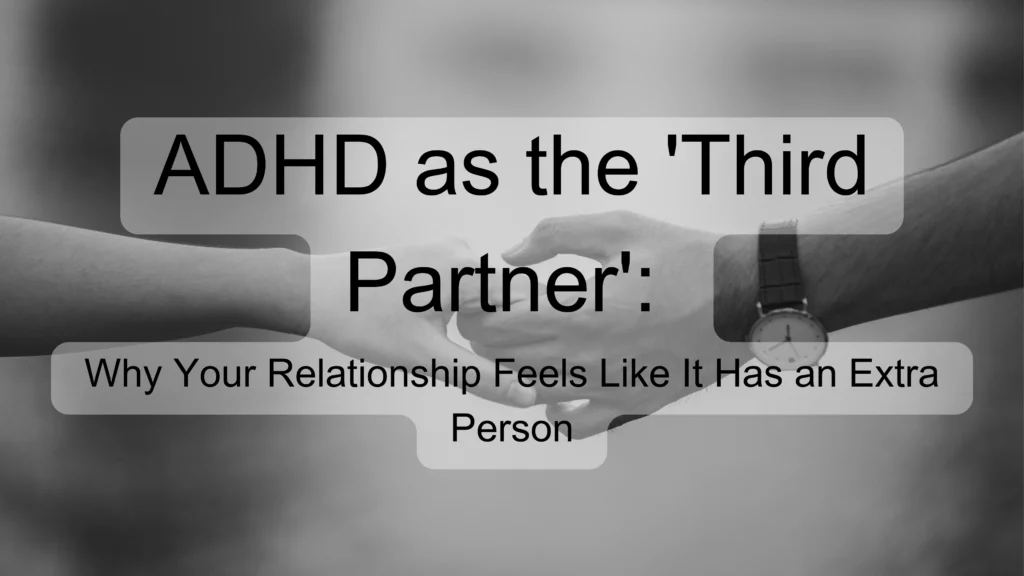ADHD as the ‘Third Partner’: Why Your Relationship Feels Like It Has an Extra Person
When ADHD becomes the invisible force shaping every moment of connection in your relationship
“Sometimes I feel like there’s someone else in this relationship with us,” Sarah told me, tears in her eyes. “Someone I can’t see, can’t talk to, but who’s always there, making decisions for both of us.”
In my four decades of couples’ work, I’ve heard this sentiment countless times. ADHD doesn’t just affect the person who has it—it becomes an invisible third presence, influencing everything from daily conversations to intimate moments.
The Hyperfocus Honeymoon Phase
ADHD relationships often begin with extraordinary intensity. The ADHD partner experiences hyperfocus on their new love—sending heartfelt messages all day, planning elaborate dates, remembering every shared detail. You feel like the center of their universe, and it’s intoxicating.
But hyperfocus is unsustainable. As novelty fades, the ADHD brain naturally shifts attention towards new stimulation. This isn’t a conscious choice or diminishing love—it’s a neurological reality.
For the non-ADHD partner, this transition feels heartbreaking. The person who once paid close attention to every word now appears distracted during conversations. The meticulous planner now forgets simple commitments. “What happened to us?” becomes an unanswerable question.
SIGN UP TO MAILING LIST
Different Brains, Different Love Languages
Here’s the crucial misunderstanding: ADHD and neurotypical partners experience love differently.
Neurotypical partners feel loved through consistency—regular check-ins, remembered plans, steady presence. They measure love through reliable actions.
ADHD partners experience love through intensity and excitement. They express affection in passionate bursts rather than steady streams. Their love is volcanic, not a flowing river.
Neither is wrong, but without understanding these differences, both may feel unloved and misunderstood.
The Devastating Misinterpretations
Three patterns destroy ADHD relationships:
“You Don’t Care Anymore” happens when attention shifts away from the relationship. The neurotypical partner sees this as proof love is fading, while the ADHD partner feels confused—their feelings haven’t changed at all.
“Why Are You Always Distracted?” occurs when the ADHD partner hyperfocuses on phones, projects, or interests. Their partner feels invisible, not understanding that ADHD hyperfocus isn’t chosen—it’s a neurological state difficult to interrupt.
“I Have to Do Everything Myself” develops as executive function challenges mount. The ADHD partner forgets appointments, loses track of time, and starts projects without finishing. The neurotypical partner compensates, becoming exhausted and resentful.
Sarah and James: A Breakthrough Story
Sarah felt invisible in her relationship with James. He’d get absorbed in work projects and seem to forget she existed. He’d promise to handle responsibilities but get distracted, leaving tasks unfinished.
James felt constantly disappointed. When Sarah expressed frustration, he’d react defensively, making everything worse.
Their breakthrough came when they understood the role of ADHD. Sarah stopped taking James’s distractibility personally, recognising it as a neurological difference. James implemented external systems—phone reminders for sweet messages, scheduled date nights, and visual cues for staying present.
They didn’t just survive—they thrived. Their relationship strengthened because they learned to work with ADHD, not against it.
Working With the Third Partner
Transformation happens when couples stop fighting ADHD and start collaborating with it. This means:
Creating external systems for things ADHD brains struggle with—shared calendars for important dates, reminders for routine tasks, structured check-ins to prevent small issues from becoming major conflicts.
Understanding that ADHD behaviours aren’t personal choices. Distractibility isn’t about not caring. Forgetfulness isn’t about not prioritising the relationship.
Recognising ADHD’s gifts alongside its challenges. The same impulsivity that causes problems also brings spontaneity. Emotional intensity enables deep empathy. Hyperfocus creates moments of complete presence when directed toward the relationship.
SIGN UP TO MAILING LIST
From Invisible Enemy to Known Ally
When couples understand ADHD as their invisible third partner, everything changes. The mysterious force controlling their relationship becomes manageable. Instead of feeling like victims of unpredictable dynamics, they become collaborators.
ADHD stops being the enemy and becomes a factor to work with. The relationship transforms from a constant struggle to a partnership that leverages neurological differences as strengths.
The challenges don’t disappear—ADHD will always affect attention, executive function, and emotions. But when both partners understand how it works and develop strategies to accommodate it, those challenges become manageable.
The invisible third partner doesn’t leave, but it stops being a source of confusion and conflict. Instead, it becomes a known quantity both partners can work with, creating relationships that are genuinely extraordinary in their depth, passion, and authentic connection.
Understanding this changes everything. You’re not fighting each other—you’re learning to dance with ADHD together.
Get your copy of Navigating Love Relationships and ADHD here!

